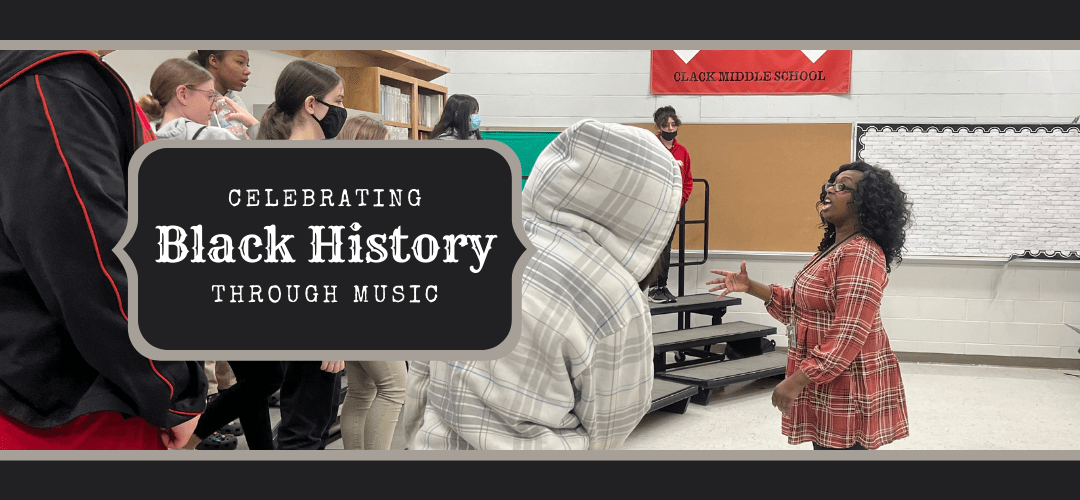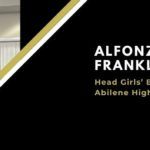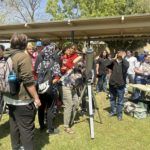Armed with the evolution of music in America, Clack Middle School choir director Shalesia Brown brought a project to her classes during the month of February to help celebrate Black History Month.
After sharing her vast knowledge of musical history, Brown tasked her students with finding and researching one Black musician from the last 100 years and finding and researching another Black musician that was influenced by their other selection.
With a long list of names of influential musicians – and the list only scratches the surface – it seems like it would be an easy task to find each of those and put together a presentation. But Brown wanted more from her students.
“This project lets them know that music is a part of American culture, no matter the genre,” said Brown, who is in her first year as a music teacher. “What we do with choral music is still all tied in because it all makes music. Music history is a cycle, and I wanted my students to see that through this project.”
So, Brown made the assignment and sat back to see how her students would handle it.
“The kids latched onto the idea really well,” she said. “When I first started this year, I was trying to get the students to even be focused in regular choir. All it took was this one project to see them at their greatest potential. The kids at all three grade levels have been so tuned in with everything about this project. I just had to give them a starting point. We couldn’t even get our normal stuff done in class because their projects and what was going on with them was all they wanted to talk about.
“I wanted to see them honed-in and engaged in the project, and that’s what I’ve seen,” said Brown, who counted Tina Turner and Beyonce as among her many musical influences. “We started small this year, but I want to implement this into my program for the rest of my career. Not only for Black History Month, but for any other month that is dedicated to a certain race. I had no idea it would turn out like this, but as I see them work it makes my heart glad.”
Clack sixth-grader Seth Gallego said the project has helped him realize that the songs of his two chosen artists speak to him in ways that other music doesn’t.
“I’ve looked up to Tina Turner and Beyonce since I was very young,” Gallego said. “My parents listened to them and I noticed how beautiful the music and tone was. I feel calm whenever I hear either one of them sing. I feel myself; I feel free.
“Beyonce’s song Halo speaks to me because of what I’ve been through recently with my aunt passing away,” he said. “I still have memories of my aunt whenever I walk into a room where she was; I still feel that connection. And that’s what Beyonce’s song is about, and that’s why it’s so important to me.”
Gallego’s sixth-grade classmate, Kynadee Whiteley, went with The Supremes as her older group and Destiny’s Child as the group influenced by The Supremes. And while many people would pick Beyonce out of Destiny’s Child as their favorite member of the group, Whiteley said, “That’s not me. My favorite is Kelly Rowland. She’s more herself and doesn’t let anyone boss her around. That’s how Diana Ross (former lead singer of The Supremes) carried herself as well.
“The Supremes had to deal with a lot of stuff because they were three Black women,” Whiteley said. “Since I’m bi-racial, I wanted to focus on the people who attracted me to music. For me that was Destiny’s Child as well as The Supremes because that’s who my mother and grandmother listened to, and still do.”
Clack eighth-grader Isaiah Rodriguez went a different direction in his selections, picking 2Pac and Kevin Gates as his two influences.
“2Pac inspired Kevin Gates to make music the way he does,” Rodriguez said. “Both of them grew up and went through some hard times before making their way. I can relate to them in a lot of ways. This whole process has been really eye-opening.”
Brown said she really developed an appreciation for the project when she attended the Texas Music Educators’ Association (TMEA) Conference earlier this month in San Antonio.
“I sat in on two specific sessions on implementing hip hop music into the classroom,” Brown said. “The speaker had taken elements of hip hop songs and put them on sheet music and let the kids soulfege (a system where every note of a scale is given its own unique syllable, which is used to sing that note every time it appears) and sing out excerpts from pieces of music.
“She did a song by a newer artist – Lil Nas X – where she took an excerpt from the instrumentation at the beginning of his music and made it into sheet music for the kids to actually do four-part harmony and that grasped the kids’ attention,” Brown continued. “Now the Black and Brown kids in her classes are able to see it’s not just choral music; their music matters, too. They can learn from this as much as the other and see how they work together. I appreciated that because the ideas she was giving us were to help those music educators, especially those who are teaching kids who relate to today’s music.”
Brown said she knew many of her students would choose artists of more recent vintage but was surprised when two of her sixth-grade students went way back into the archives for their selections.
“We’ve had students choose artists from Jazz, R&B, Blues, Hip Hop, Rap and Rock ’N Roll, which isn’t surprising,” Brown said. “But I had two students come to me and went back to Shirley Caesar (a gospel artist whose career began as a 13-year-old in 1951) and The Williams Brothers (a gospel group formed in 1960 and still performing today). These girls come from a family of pastors and ministers, so I’m not surprised they knew them, but I was surprised they chose those names.”
But it’s that kind of selection that makes the project worthwhile. Those two students will stand in front of their classmates and tell them who Ceasar and the Williams Brothers are and how their music has impacted them and the world. And that’s the whole point, Brown said.
“I hope the students develop an appreciation for those who have been able to – from the time Black Americans were able to have the freedom to do so – take an appreciation of knowing what happened 100-200 years ago is the reason why they’re able to enjoy what we have now,” Brown said. “I don’t want them disregarding something just the music might sound old. The second thing is figuring how what it takes to make a well-rounded musician because it all works together. A lot of the greats in every genre have explored different styles and different genres to come up with their sound. And I think it’s probably made them appreciate it more when they explore every aspect. I hope my students can put do the same thing with this project.”
The choir at Clack isn’t the only group doing something on campus to commemorate Black History Month. Art teacher JD Humber put together a project for the Fine Arts teachers on campus to participate in and it’s now on display at the end of the Fine Arts hallway.
Humber asked each of the Fine Arts teachers at Clack to give him a person from their field to showcase. Humber then put them together, added photos of each person and some background art to create the display.
“The visual art person from my area was Alma Woodsey Thomas,” Humber said. “Her style of painting was what I imitated for the background of the case. Plus, I included several Black inventors that have made massive contributions to our society. That was the idea behind the case.”
Some of the names included in the case are musician Wynton Marsalis, Alfred Cralle (inventor of the ice cream scoop), Brittan Brown (inventor of the home security system), Garrett Morgan (inventor of the gas mask and the traffic light), Charles Richard Drew (inventory of the blood bank), John Lee Love (inventor of the pencil sharpener), George T. Simpson (inventory of the clothing dryer), Leslie Odom Jr. (actor), and Florence Price (composer).
“I was hoping for the Fine Arts team to be in unison in celebrating Black History Month, and I believe we were,” Humber said. “The team was pleased with the outcome, as well as other faculty and staff members. I wanted to show our students that the contributions to the arts and culture has been hugely influenced by Black Americans. Theirs is a heritage that is worth being proud of.”












